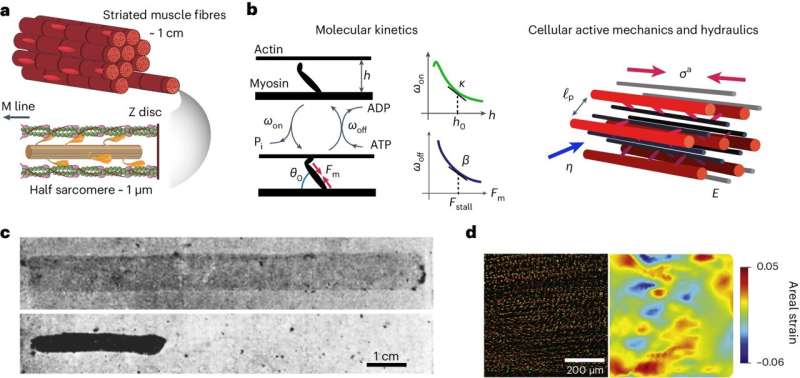
Muscle fibers are soft, wet, active, multi-scale engines. Credit: Physics of nature (2024). DOI: 10.1038/s41567-024-02540-x
According to a study from the University of Michigan, the flow of water into a muscle fiber can determine how quickly the muscle can contract.
Almost all animals use muscles to move, and it has long been known that muscles, like all other cells, are composed of about 70 percent water. But researchers don’t know what determines the range and upper limits of muscle performance. Previous research on how muscles work has focused only on how they work at the molecular level, rather than on the shape of muscle fibers, the fact that they are three-dimensional and filled with fluid.
UM physicist Suraj Shankar and L. Mahadevan, a professor of physics at Harvard University, created a theoretical model of the role of water in muscle contraction and found that the way fluid moves through a muscle fiber determines how quickly a muscle fiber can contract.
They also discovered that the muscle exhibits a new type of elasticity called odd elasticity that allows the muscle to generate power using three-dimensional deformations, as evidenced by a common observation that when a muscle fiber contracts lengthwise, it also expands perpendicularly. Their findings are published in the journal Physics of nature.
“Our results suggest that even fundamental questions like the speed of muscle contraction or the different ways in which muscle can generate energy find new and unexpected answers when we take a more integrated and holistic view of muscle as a complex, hierarchical material rather than just a bag of molecules,” Shankar said. “Muscle is more than the sum of its parts.”
Researchers envision each muscle fiber as a self-compressing active sponge, a water-filled, sponge-like material that can contract and compress through the action of molecular motors, he says.
“Muscle fibers are made up of many components, such as various proteins, cell nuclei, organelles like mitochondria, and molecular motors like myosin that convert chemical fuel into movement and drive muscle contraction,” Shankar explained. “All of these components form a porous network bathed in water. So a crude and apt description of muscle is that of an active sponge.”
But the squeezing process takes time to displace water, so the researchers assumed that this movement of water through the muscle fiber set an upper limit on how fast a muscle fiber can contract.
To test their theory, they modeled muscle movements in a range of organisms including mammals, insects, birds, fish, and reptiles, focusing on animals that use muscles for very fast movements. They found that muscles that produce sounds, such as the rattle in a rattlesnake’s tail, which can contract ten to a hundred times a second, typically do not rely on fluid flow. Instead, these contractions are controlled by the nervous system and are more strongly dictated by molecular properties, or the time it takes for molecular motors in cells to bind together and generate forces.
But in smaller organisms, such as flying insects that beat their wings a few hundred to a thousand times per second, these contractions are too fast for neurons to control directly. In these cases, fluid flows are greater.
“In these cases, we found that fluid flows within the muscle fiber are important and that our active hydraulics mechanism is likely to limit the fastest contraction rates,” Shankar said. “Some insects such as mosquitoes appear to be close to our theoretically predicted limit, but direct experimental tests are needed to verify and challenge our predictions.”
The researchers also found that when muscle fibers act like an active sponge, the process also causes the muscles to act like an active elastic motor. When an object is elastic, like a rubber band, it stores energy as it tries to resist deformation. Imagine holding a rubber band between two fingers and pulling it back.
When you release the rubber band, it also releases the energy stored when it was stretched. In this case, energy is conserved, a fundamental law of physics that states that the amount of energy in a closed system must remain the same over time.
But when the muscle converts chemical fuel into mechanical work, it can produce energy like an engine, violating the law of conservation of energy. In this case, the muscle exhibits a new property called “strange elasticity,” where its response when squeezed in one direction rather than another is not mutual.
Unlike the rubber band, when the muscle contracts and relaxes along its entire length, it also inflates perpendicularly and its energy does not remain the same. This allows the muscle fibers to generate power from repetitive deformations, behaving like a flexible motor.
“These results contradict the prevailing thinking, which focuses on molecular details and neglects the fact that muscles are long and filamentous, that they are hydrated and that they have multi-scale processes,” Shankar said.
“Overall, our results suggest that a revised view of how muscles function is essential for understanding their physiology. It is also crucial for understanding the origins, extent, and limits underlying diverse forms of animal movement.”
More information:
Suraj Shankar et al, Active hydraulics and strange elasticity of muscle fibers, Physics of nature (2024). DOI: 10.1038/s41567-024-02540-x
Provided by the University of Michigan
Quote: Muscle machine: How water controls the speed of muscle contraction (2024, July 11) retrieved July 11, 2024 from https://phys.org/news/2024-07-muscle-machine.html
This document is subject to copyright. Apart from any fair dealing for the purpose of private study or research, no part may be reproduced without written permission. The content is provided for informational purposes only.